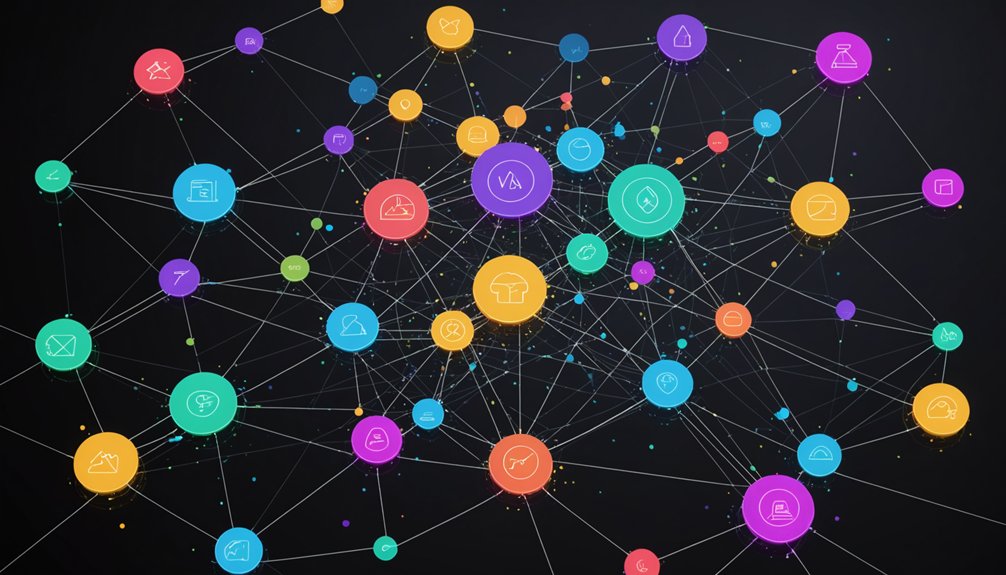AI-driven customer segmentation revolutionizes business by transforming basic demographic sorting into dynamic, behavior-based groupings. Companies analyze data in real-time across multiple channels, delivering personalized messaging to millions simultaneously. This advanced approach yields higher conversion rates, improved ROI, and reduced marketing waste. Businesses using AI segmentation build stronger customer relationships and gain competitive advantage through faster, deeper insights. Clean data remains essential for accuracy. The difference between thriving and just surviving? Often comes down to who knows their customers better.

How dramatically has customer segmentation changed in the digital age? The shift is staggering. Gone are the days of simple demographic sorting—age, location, income. Boring. AI has completely transformed how businesses slice and dice their customer base, and the results are nothing short of revolutionary.
AI doesn’t just look at the obvious markers. It digs deep. It identifies patterns human analysts would miss in a million years. The machines are sifting through mountains of data across multiple channels simultaneously, spotting correlations that actually matter. And they’re doing it in real-time, not six months after a trend has already died.
AI reveals the invisible—finding patterns in behavioral chaos that human analysts could never detect, delivering insights at superhuman speed.
These AI systems create nuanced, behavior-based groupings that evolve constantly. No more static customer profiles gathering dust. The segments shift as customer behaviors change—because let’s face it, humans are fickle creatures. This dynamic approach means businesses can adapt on the fly, keeping marketing efforts relevant. Always. Machine learning algorithms continuously optimize campaign performance by analyzing customer responses and engagement patterns.
The practical impact? Higher conversion rates. Better ROI. Less wasted money on marketing that misses the mark. AI guarantees resources go where they’ll actually produce results. What a concept. Modern sentiment analysis tools like IBM Watson help businesses understand customer emotions and preferences at unprecedented scales.
Personalization at scale is now possible. Businesses can tailor messages to thousands—even millions—of customers simultaneously. Each communication feels personal, crafted just for them. It’s not. But it feels that way, and that’s what matters.
This technology works across industries. Banking. Lawn care. Retail. Whatever. The principles remain the same: understand behaviors, predict needs, deliver relevant messaging.
The competitive advantage is clear. Companies leveraging AI segmentation build stronger customer relationships and boost lifetime value. Their marketing dollars work harder. Their messages resonate better.
Traditional segmentation methods just can’t compete. They’re too slow, too clunky, too shallow. AI dives deeper, moves faster, and adapts continuously.
For businesses serious about growth, AI-driven segmentation isn’t just nice to have. It’s essential. The market doesn’t wait. Neither should they.
Strong data hygiene practices are fundamental to ensuring the insights generated by AI segmentation are accurate and actionable rather than misleading.
AI can analyze social media activity and online behavior for enhanced accuracy in customer segmentation, delivering more personalized marketing experiences than ever before.
Frequently Asked Questions
How Much Does AI Segmentation Software Typically Cost?
AI segmentation software costs vary wildly. Custom solutions? $6,000 to a whopping $300,000. Third-party tools are cheaper—anywhere from free to $40,000 annually. The price tag depends on complexity, features, and scalability needs.
Implementation adds more expenses: assessment ($5,000-$25,000), development ($30,000-$100,000), plus integration and data prep costs.
Don’t forget ongoing maintenance.
Businesses pay more for advanced features like predictive modeling. The tech isn’t cheap, but it’s faster than humans.
What Skills Do Teams Need to Implement AI Segmentation?
Teams implementing AI segmentation need a mix of technical and soft skills.
Data analysis is vital—no way around it. Machine learning knowledge helps, too. They’ll need visualization chops to make sense of complex patterns.
Communication skills? Absolutely essential. Someone’s gotta explain these fancy algorithms to the marketing folks.
Integration capabilities matter. So does cybersecurity awareness—customer data isn’t something to mess around with.
And let’s not forget adaptability. AI tools change fast. Really fast.
Can Small Businesses Benefit From AI Segmentation?
Absolutely. Small businesses can leverage AI segmentation without breaking the bank.
The technology’s increasingly user-friendly, making sophisticated customer targeting accessible to mom-and-pop shops. Real-time insights help these smaller players compete with industry giants. They’ll optimize marketing spend, boost ROI, and create personalized experiences that larger competitors often struggle to match.
Plus, it eliminates human error in data analysis. Small business, big data advantage. The playing field’s leveling out.
How Long Does AI Segmentation Implementation Usually Take?
AI segmentation implementation timelines vary greatly. Typically, it takes 3-6 months from start to finish. Companies with clean data and technical resources might complete it in weeks. Others? Could be a year. No joke.
Phases matter. Initial setup is quick. The real time-sink? Data preparation and integration. Pilot projects accelerate the process.
Bottom line: implementation speed depends on data quality, existing infrastructure, and resources. Some businesses hit the ground running. Others crawl.
What Privacy Concerns Arise With Ai-Driven Customer Data Analysis?
AI-driven customer data analysis raises serious privacy flags.
Companies vacuum up personal information—behaviors, preferences, demographics—often without clear consent. Creepy stuff.
AI’s ability to infer sensitive details about people makes it worse. Legal headaches follow when businesses ignore regulations like GDPR and CCPA.
Trust gets shattered when consumers discover their data’s being mined without transparency. The tech can slice and dice information so finely that anonymity becomes a joke.
Privacy? What privacy?




